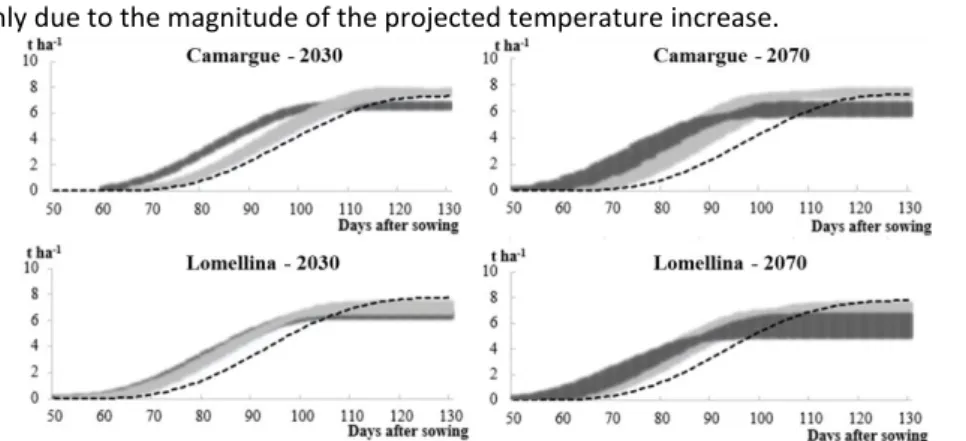HAL Id: hal-02741623
https://hal.inrae.fr/hal-02741623
Submitted on 3 Jun 2020
HAL is a multi-disciplinary open access
archive for the deposit and dissemination of
sci-entific research documents, whether they are
pub-lished or not. The documents may come from
teaching and research institutions in France or
abroad, or from public or private research centers.
L’archive ouverte pluridisciplinaire HAL, est
destinée au dépôt et à la diffusion de documents
scientifiques de niveau recherche, publiés ou non,
émanant des établissements d’enseignement et de
recherche français ou étrangers, des laboratoires
publics ou privés.
Identifying trends and sources of uncertainty in
potential rice productions under climate change in
Mediterranean countries
Simone Bregaglio, Laure Hossard, Giovanni Allessandro Cappelli, Francoise
Ruget, Sylvestre Delmotte
To cite this version:
Simone Bregaglio, Laure Hossard, Giovanni Allessandro Cappelli, Francoise Ruget, Sylvestre
Del-motte. Identifying trends and sources of uncertainty in potential rice productions under climate
change in Mediterranean countries. iCROPM 2016 International Crop Modelling Symposium ”Crop
Modelling for Agriculture and Food Security under Global Change”, Knowledge Hub FACCE
MAC-SUR. INT.; Agricultural Model Intercomparison and Improvement Project (AgMIP). USA., Mar 2016,
Berlin, Germany. 437 p. �hal-02741623�
International Crop Modelling Symposium
15-17 March 2016, Berlin
210
Identifying trends and sources of uncertainty in potential rice
productions under climate change in Mediterranean countries
S. Bregaglio 1 – L. Hossard 2 – G. Cappelli 1 – F. Ruget 3 – S. Delmotte 2 1
Department of Agricultural and Environmental Sciences, University of Milan, via Celoria 2, 20133 Milan, Italy, simone.bregaglio@unimi.it
2
Innovation and Development in Agriculture and Food, INRA, Montpellier, France
3
Modelling agricultural and hydrological systems in the Mediterranean environment, INRA, Avignon, France
Introduction
The overall impact of climate change on rice productions is expected to be uncertain in the world top producing countries (Tao and Zhang, 2013; Zhang et al., 2014), whereas it has not yet been evaluated in Europe, where it plays a pivotal sociocultural and ecological role (Longoni, 2012). European rice is grown in continuous flooding with high fertilizations in a Mediterranean climate, therefore main constraints are cold temperatures (Jena and Hardy, 2012) leading to damages from sowing (germination efficiency) to flowering, when temperature ranges increase the risk of pollen sterility. This paper presents the application of the rice model WARM (Confalonieri et al., 2009) to simulate potential yields in current and future climate conditions in two main European rice-producing areas, the Italian Lomellina and the French Camargue. The main objectives are the quantification of the main trends of future rice productions and the identification of the sources of uncertainty in climate change projections.
Materials and Methods
The WARM model was calibrated and evaluated against 20 field datasets with dynamic data of aboveground biomass and leaf area index, collected in the two case studies in the period 1987-2009. Rice varieties belonged to Japonica type. Synthetic 20-years weather series were generated starting from baseline data (1991-2010) according to the projections of four General Circulation Models (GCMs) and two representative CO2
concentration pathways (RCPs; +2.6 W m-2 and +8.5 W m-2). Two time horizons were considered, 2030 and 2070. Uncertainties in model estimates were assessed by analysis of variance using the GLM procedure (Olesen et al., 2007).
Results and Discussion
Figure 1 shows daily simulated dynamics of yields in Lomellina and Camargue according to various GCMs and RCPs. Model outputs highlight an increasing anticipating trend in the accumulation of grain biomass in 2030 and 2070, mainly due to the shortening of the crop cycle. A different impact of climate change in the two areas can be observed. Camargue rice productions will be quite stable in 2030 (+4.1% ÷ -13.8%) and will decline in 2070 (+2.6% ÷ -31.7%). Lomellina will experience higher yield reductions, with a steep decrease in 2030 (-10.1% ÷ -24.6%) and an even more
International Crop Modelling Symposium
15-17 March 2016, Berlin
211
impact in 2070 (-8.8% ÷ -47.5%). The differences between the two study areas are mainly due to the magnitude of the projected temperature increase.
Figure 1. Daily average simulated values (20 years) of grain biomass in Camargue and Lomellina. Dark grey shades refer to GCM Hadley, light grey to MIROC in Camargue and GISS in Lomellina and indicate the
min./max. value of the outputs of the two RCPs. Baseline data are indicated as dotted black line. Table 1. Results of the GLM ANOVA carried out on 20-year series of final yields
Factor d. f. MS P-value Partial R2 R2 RMSE
GCM 3 30.92 <0.001 0.33 0.63 0.402
RCP 1 21.29 <0.001 0.08
Site 1 49.10 <0.001 0.18
Time horizon 1 13.02 <0.001 0.05
Table 1 presents the results of the ANOVA performed on final simulated yield. When considering rice yields in both sites together for a 20-year series, all factors are highly significant. GCM is the top contributor to explain the variation of simulated yields.
Conclusions
The overall impact of climate change on European rice yields is expected to be negative in 2030 (-10%) and in 2070 (-15.8%) and variable across sites. The uncertainty in GCMs projections deeply impact on model outputs. Next step is the evaluation of adaptation strategies to reduce climate change impacts on rice productions.
Acknowledgements
This research is being conducted within the Scenarice project (n°1201-008) funded by the Agropolis and Cariplo foundations.
References
Confalonieri, R., A.S. Rosenmund, B. Baruth (2009). Agronomy for Sustainable Development, 29: 463–474. Jena, K.K. and B. Hardy (2012). International Rice Research Institute, Los Banos, 105 pp.
Longoni, V. (2012). Waterbirds, 35: 83–96.
Olesen, J.E., R.T. Carter, C.H. Diaz-Ambrona et al., (2007). Climatic Change, 81: 123–143. Tao, F. and Z. Zhang (2013). Journal of Applied Meteorology and Climatology, 52: 531–551. Zhang, S., F. Tao and Z. Zhang (2014). European Journal of Agronomy, 54: 70–83.
